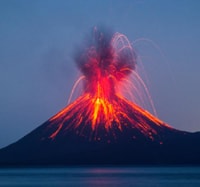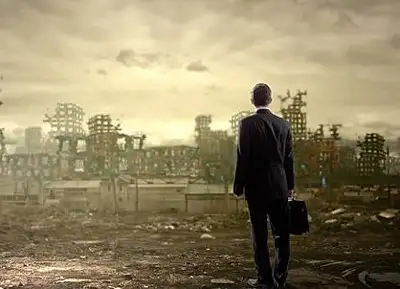English Documentary on Volcanoes
English Documentary on Volcanoes
Portals into the heart of the earth, they burn bottomless cauldrons fueled by an ancient wrath. Bubbling and boiling thousands of miles beneath the surface and just waiting to burst through.
Volcanoes are scattered across the planet and about 1,500 active volcanoes can be found across the world. Though, others are on the ocean floor. Most volcanoes, whether on land or underwater, are located where tectonic plates meet. In fact, the ring of the fire, a path that traces the boundaries between several tectonic plates around the Pacific Ocean, contains about 75% of the planet’s volcanoes.
There are several types of volcanoes, primarily classified by shape and size. Major types include – Strato volcanoes which often appear as tall steep mountains; shield volcanoes which are flatter and dome shaped; Calderas which are large depressions in the ground and mid-ocean ridges which are underwater chains of volcanic mountains.
No matter their shape and size, all volcanoes emit gas and molten rock. The journey of these emissions begins deep underground in the Earth’s core which can burn as hot as the surface of the sun transfers its heat to the surrounding rocky mantle. In doing so, the heat melts some of the rocks. This molten rock or magma is lighter than the surrounding solid rock layer. So, it rises through the mantle. The magma then escapes through vents in the Earth’s crust causing volcanic eruptions.
Now above-ground, this magma is referred to as lava and it can reach temperatures of over 2,000 degree Fahrenheit. In addition to lava, volcanoes may erupt with searing hot gas formed in the mantle in a phenomenon called Pyroclastic flow. This gas, combined with hot ash, can race down the sides of the volcano as fast as 100 miles per hour burning everything in its path.
To measure and classify eruptions, scientists developed the Volcanic Explosivity Index or VEI. It considers various factors such as the volume of lava, gas and other emissions from the volcano, along with the height of the eruption cloud above the volcano’s summit. The VEI scale begins at zero. Each successive measurement increases Logarithmically, meaning that each magnitude is 10 times more powerful than the one before it. The VIE scale does not have an upper limit, but the most catastrophic eruptions measured thus far, are categorized as VEI 8.
These eruptions occurred thousands and millions of years ago. The most destructive volcanic eruptions ever witnessed occurred in Indonesia in 1815. Mount Tambora, a large stratovolcano, erupted with VEI measurement of 7. The blast caused earthquakes, tsunamis and Pyroclastic flows that decimated the land and took tens of thousands of Indonesian lives. The eruption even destroyed the top of Mount Tambora itself, turning the 13000 foot tall mountain into a three thousand six hundred and forty foot deep caldera.
While Volcanoes are some of the most destructive forces of nature, they have also helped make life on earth possible. Volcanic ash provides nutrients to nearby soil making the land fertile and lava, when it cools, hardens into rocks and creates new land forms. With heat from the heart of the earth, volcanoes have helped para form the planet, making it the rich, dynamic landscape we see today.




I did not understand the meaning of this
1. volcanoes have helped para from the planet…
Would you please explain it.
2. Fueled by ancient wrath. Ancient wrath refer to what here.
1. Volcanos have helped para-form the planet = they have given an overall shape to the planet, that is, the external layer of high flats on Earth
I should add that the transcriber has made a minor mistake in her transcription; ‘from’ should change to ‘form’, and I edited that part, thanks to your attention.
2. Ancient wrath is a metaphor in this documentary as a figure of speech in which the earth is likened to an angry and wrathful monster or beast that bursts out extremely heated eruptions in the form of lava.
portals into the heart of the earth, they burn bottomless cauldrons fueled by an ancient wrath. Bubbling and boiling thousands of miles beneath the surface and just waiting to burst through.
Volcanoes are scattered across the planet and about 1,500 active volcanoes can be found across the world. Though, others are on the ocean floor. Most volcanoes, whether on land or underwater, are located where tectonic plates meet. In fact, the ring of the fire, a path that traces the boundaries between several tectonic plates around the Pacific Ocean, contains about 75% of the planet’s volcanoes. There are several types of volcanoes, primarily classified by shape and size, major types include – Strato volcanoes which often appear as tall steep mountains, Shield volcanoes which are flatter and dome shaped, Calderas which are large depressions in the ground and mid-ocean ridges which are underwater chains of volcanic mountains. No matter their shape and size all volcanoes emit gas and molten rock. The journey of these emissions begins deep underground in the Earth’s core which can burn as hot as the surface of the sun transfers its heat to the surrounding rocky mantle. In doing so, the heat melts some of the rocks. This molten rock or magma is lighter than the surrounding solid rock layer so it rises through the mantle. The magma then escapes through vents in the Earth’s crust causing volcanic eruptions. Now above-ground, this magma is referred to as lava and it can reach temperatures of over 2,000 degree Fahrenheit. In addition to lava, volcanoes may erupt with searing hot gas formed in the mantle in a phenomenon called pyroclastic flow. This gas, combined with hot ash, can race down the sides of the volcano as fast as 100 miles per hour burning everything in its path. To measure and classify eruptions, scientists developed the volcanic explosivity index or VEI. it considers various factors such as – The volume of lava, gas and other emissions from the volcano, along with the height of the eruption cloud above the volcano’s summit. The VEI scale begins at zero. Each Successive measurement increases Logarithmically, meaning that each magnitude is 10 times more powerful than the one before it. The VIE scale does not have an upper limit, but the most catastrophic eruptions measured thus far, are categorized as VEI 8. These eruptions occurred thousands and millions of years ago. The most destructive volcanic eruptions ever witnessed occurred in Indonesia in 1815. Mount Tambora, a large stratovolcano, erupted with VEI measurement of 7. The blast caused earthquakes, tsunamis and pyroclastic flows that decimated the land and took tens of thousands of Indonesian lives. The eruption even destroyed the top of Mount Tambora itself, turning the 13000 foot tall mountain into a three thousand six hundred and forty foot deep caldera. While Volcanoes are some of the most destructive forces of nature, they have also helped make life on earth possible. Volcanic ash provides nutrients to nearby soil making the land fertile and lava, when it cools, hardens into rocks and creates new landforms. With heat from the heart of the earth, volcanoes have helped para from the planet, making it the rich, dynamic landscape we see today.
That’s marvelous! Thank you so much.